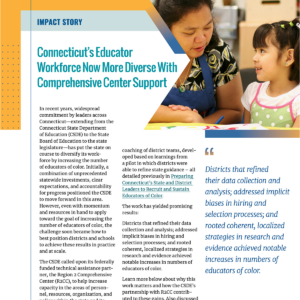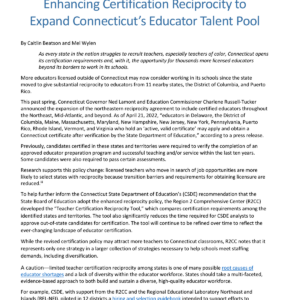Connecticut Experiences Influx of Teacher Talent, Moves to Double Number of States With Qualified Educator Reciprocity
Posted on

With protocols to maintain high talent standards developed by the Region 2 Comprehensive Center, the state is expanding the channel to educators in 10 Midwestern and Southern states.
Qualified educators from 10 Midwestern and Southern states are now—along with 13 other states and jurisdictions recently deemed “reciprocal” by the Connecticut State Department of Education (CSDE)—able to apply for teaching certification reciprocity in Connecticut. This substantial move to open up new paths that allow students the benefit of access to diverse, talented educators was made possible because a Region 2 Comprehensive Center (R2CC) state-by-state scan helped the CSDE identify other states whose certification requirements align with Connecticut’s high standards for teacher certification.
As of March 1, 2024, educators from Alabama, Georgia, Illinois, Indiana, Michigan, North Carolina, Ohio, South Carolina, Tennessee, and Wisconsin who hold valid out-of-state licenses can obtain, at a minimum, a 3-year initial educator certificate in Connecticut.
“The state’s willingness to extend recognition to additional states whose certification requirements align with its own standards demonstrates a forward-thinking approach to addressing educator challenges,” notes Mel Wylen, who led this research for the R2CC.
Initially, in the spring of 2022, Connecticut’s state board of education expanded reciprocity with Northeastern states and jurisdictions, including Delaware, the District of Columbia, Maine, Maryland, Massachusetts, New Hampshire, New Jersey, New York, Pennsylvania, Puerto Rico, Rhode Island, Vermont, and Virginia, enabling educators already certified in those states to apply and obtain a Connecticut certificate following verification by the CSDE.
The CSDE originally identified these particular states by using a “Teacher Certification Reciprocity Tool” developed by the R2CC at the state’s request. The tool informed the state of reciprocity policies in its own region and the Southeast region and facilitated evidence-based decision-making to identify others whose certification requirements closely aligned with Connecticut’s initial educator certificate standards.
“R2CC made it possible for CSDE to comprehensively consider this expansion based on a data-driven approach, expanding the pool of qualified teachers and reducing the barriers to entry,” said CSDE Deputy Commissioner Sinthia Sone-Moyano. “The Teacher Certification Reciprocity Tool also paved the way for a simplified transition and equitable process for educators holding valid out-of-state licenses.”
For more on the R2CC’s process and to access the tool itself, see Enhancing Certification Reciprocity to Expand Connecticut’s Educator Talent Pool.
Preliminary results. As a result of that initial wave of enhanced reciprocity, between April 2022 and March 2024, Connecticut issued 977 new educator certificates to candidates from those Northeastern states, along with 2,442 “endorsements,” or specializations that provide greater opportunity to be hired in specific subject areas such as English as a Second Language and Gifted and Talented Education.
Enhanced reciprocity has already supported staffing in 170 districts across the state.
“It is encouraging to see the results of Connecticut’s enhanced reciprocity policy and the impact it is having on reducing educator shortages and increasing the diversity of Connecticut’s educator workforce,” said Sarah Barzee, director, R2CC. “By embracing a rich diversity of teaching talent, the state is paving the way to create a more inclusive and culturally responsive educational experience for its students.”
After seeing a spike in out-of-state applications in 2023, the CSDE requested that the R2CC expand on the Teacher Certification Reciprocity Tool by conducting a follow-up scan to include an additional 10 Midwestern and Southern states to further address the state’s pressing teacher shortage while simultaneously fostering a more diverse teaching workforce.
The national trend. The R2CC reports that this level of reciprocity is fairly novel.
“Not many states offer full reciprocity,” notes Wylen. “However, many states are beginning to expand or enhance reciprocity pathways to reduce barriers into the educator workforce. CSDE’s intentional strategy to leverage R2CC’s support to make data driven decisions ensures that the states to which enhanced reciprocity was extended were aligned with Connecticut’s high standards for certification. Utilizing data to drive educator workforce policy decisions is of paramount importance to maintain the profession’s high standards and ensure that students receive high-quality instruction.”
Wylen adds that varying licensure requirements and limited reciprocity between states creates obstacles for both novice and experienced teachers, making it difficult for existing licensure holders to obtain a certificate or license in a new state and limiting career opportunities.
In some states, she notes, even experienced teachers may be required to retake basic skills tests, pass subject matter examinations, and complete additional coursework to obtain the type of licensure they held in another state.
For these reasons, many states have passed regulations or policies to mitigate these barriers. Since March 2024, 34 states offer a path to licensure through some form of reciprocity.
“The good news is that we are seeing states increasingly offering reciprocity for educator certification to facilitate teacher mobility, address teacher shortages, attract a diverse pool of educators, including those with valuable expertise and experiences, and smoothly transition teachers from state to state,” said Wylen. “This ultimately benefits students by ensuring that they have access to well-prepared and experienced educators.”
She adds that a complex interplay of factors determines the effectiveness of reciprocity policies in addressing educator shortages and that research suggests that reciprocity policies can potentially alleviate teacher shortages by facilitating teacher mobility between states.
Professional licensing requirements for teachers can either impede or enable teacher mobility depending on their stringency. Research shows that reciprocity policies may attract out-of-state teachers and help diversify the educator pool; however, researchers warn that because of the differing certification requirements across states, states with less rigorous certification requirements may, through expanded reciprocity, negatively impact the quality of instruction students receive.
This fall, WestEd’s Center for Standards, Assessment, and Accountability will publish a new guide to demystify complex legislation and regulations governing initial teacher certification and reciprocity in addition to national trends in teacher preparation. The guide will outline national trends, legislation and regulations governing initial licensure, alternative pathways, and reciprocity across 50 states and Washington, DC, and highlight promising practices.
Wylen concludes: “As the nation grapples with teacher shortages and the need for a more representative teaching force, Connecticut’s collaborative partnerships, data-driven decision-making, and a commitment to progress are helping the state lead the charge in transforming the educational landscape, one teacher at a time.”
The contents of this post were developed by the Region 2 Comprehensive Center. The Region 2 Comprehensive Center is funded by a grant from the U.S. Department of Education. However, the contents of this post do not necessarily represent the policy of the Department of Education, and you should not assume endorsement by the federal government.


